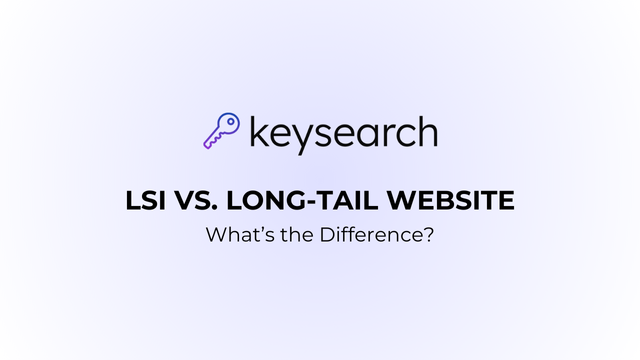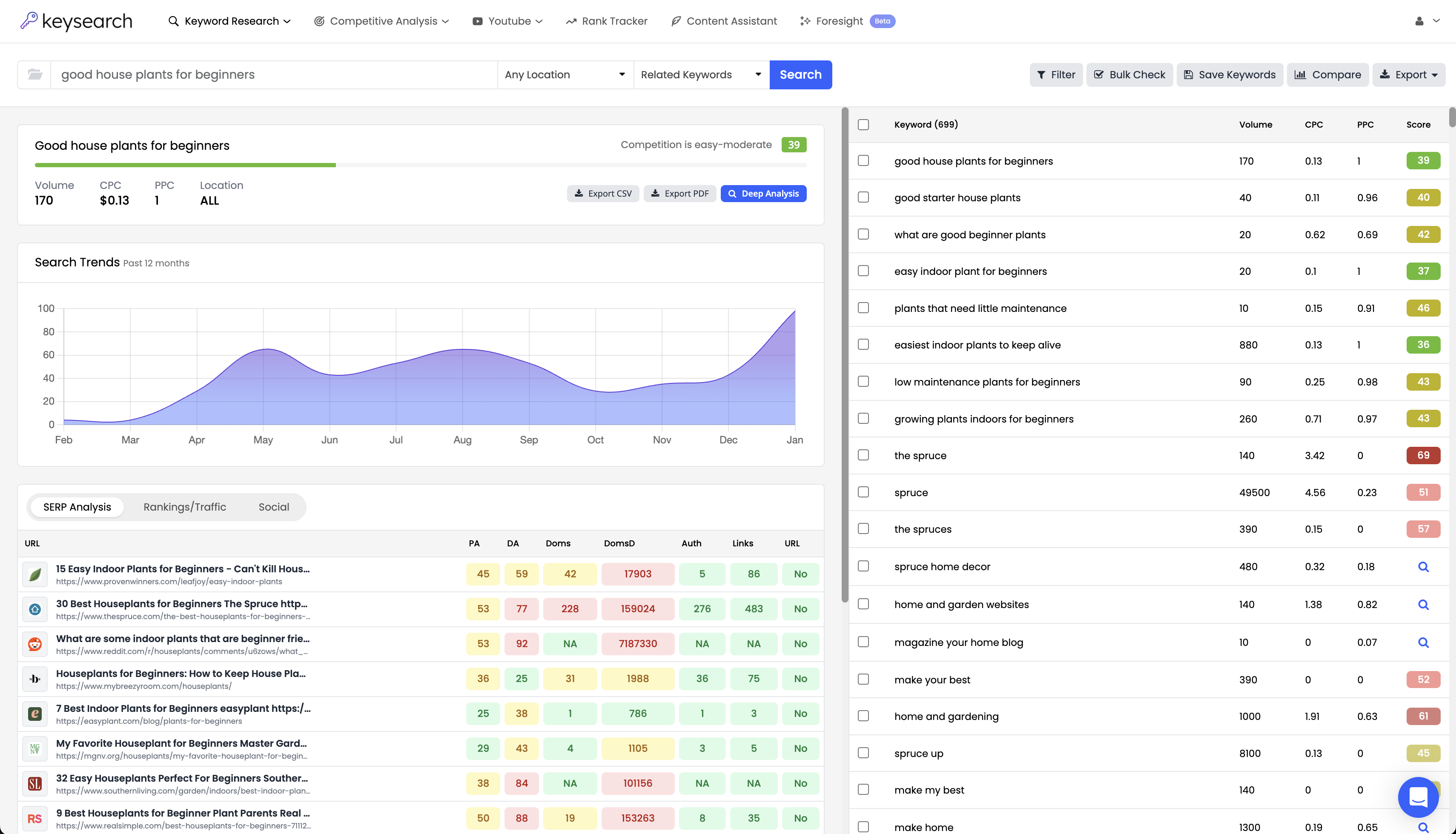Keywords in general are the terms users search when trying to find specific information, products, or services. But there are many different types of keywords, each of which has its place in helping you plan and execute an effective SEO strategy.
Today, we’ll compare and contrast two very common variations: LSI vs long tail keywords. They’re often confused for one another but are very different.
LSI (Latent Semantic Indexing) keywords are contextually related to your primary keyword and help search engines understand the content’s topic more comprehensively. If your primary keyword is “running shoes,” LSI keywords might include “jogging footwear,” “athletic sneakers,” or “marathon gear.”
In contrast, long tail keywords are more specific, often longer variations of your primary keyword. They’re far less competitive and lead to higher conversion rates. For example, “women’s running shoes for flat feet” is a long tail variation of the broad keyword “running shoes.”
While both LSI and long tail keywords help improve content relevance and search visibility, they serve different roles in your SEO strategy. It’s not necessarily a matter of choosing between one or the other – you need both!
That’s why we encourage you to leverage our free SEO tools, as we have both an LSI keyword generator and long tail keyword generator so you can create and execute the most comprehensive SEO strategy possible. Get started today or learn more below!
What are LSI Keywords?
Let’s take a deeper look at the role LSI keywords play in helping Google – or any other search engine, for that matter – understand your content.
These are conceptually related to your primary keyword, which helps the algorithm in question understand the broader context of your content and its relevance to a user’s query.
We used a running shoes example above, but let’s look at it from a different angle. Say your main keyword is “digital marketing” – LSI keywords might include “online advertising,” “SEO strategies,” and “content marketing.”
Naturally incorporating these related terms into your text helps search engines confirm the topic and improves the likelihood that your content will rank for not just the main keyword in question but any related variations.
As with any type of keyword, though, you need to use LSI keywords naturally within your content. Stuffing them in just for the sake of satisfying SEO goals can hurt readability and user experience, which in turn can negatively impact your rankings.
What are Long Tail Keywords?
Now, let’s unpack the other half of the LSI vs long tail keywords debate. Long-tail keywords are highly specific, often longer search phrases that target niche segments of an audience.
They typically consist of three or more words and are used by someone who has a clear intent in mind. For example, instead of searching for “running shoes,” a long tail keyword might be “best running shoes for flat feet women.”
The reason you should use these comes down to specificity. Because they target more precise queries, they often have lower search volume but also face less competition, making it easier to rank for them.
Plus, those searching with long tail keywords tend to be further along in the buying process, which means they’re more likely to convert – whether that means making a purchase, signing up for a service, or taking some other desired action.
LSI vs Long Tail Keywords: Key Differences to Consider
You should have a better understanding of the main differences between LSI vs long tail keywords at this point, but if not, we’ll break it down even further below.
Target Audience and Search Intent
Aligning your content with the search intent of your target audience is the foundation of SEO. Search engines want to serve users with the most relevant content possible, and that’s where you’ll see the most striking differences between LSI keywords and long-tail keywords.
LSI keywords help search engines understand the broader context of your content, appealing to a wide range of search intents that may be loosely related to your primary keyword. This attracts a diverse audience that might be exploring related topics.
On the other hand, long tail keywords are much more targeted toward specific user intents. People using these typically have a clear idea of what they’re looking for, which means they are closer to making a decision, whether it’s purchasing a product or seeking specific information.
Competition and Search Volume
You’ll also see differences in LSI vs long tail keywords in assessing search volume and difficulty. LSI keywords can often be primary keywords themselves, meaning they’ll have much higher search volume, and in turn, higher difficulty.
In contrast, long tail keywords have lower search volume but significantly less competition. They can be a gold mine for newer or smaller sites with less authority.
While you might not attract as much traffic with each individual long tail keyword, the traffic you do attract is likely to be highly targeted and more likely to convert, which can be more beneficial in the long run.
If you want to learn more about what is a good keyword difficulty score, try using our keyword difficulty checker feature at Keysearch. It will help you set your expectations realistically.
Content Optimization Strategies
The way you actually go about using LSI and long tail keywords is usually different, too. The strategy of incorporating LSI keywords into your content is usually going to involve adding them to subheadings, body text, and image alt texts. You might look at these as “secondary keywords.”
But long tail keywords are a bit more versatile. You can use them as secondary keywords in a similar way you’d use LSI keywords, or you can make them the primary keyword if you’re focusing on more relevant, low-difficulty opportunities.
That means you’ll be more meticulous in how you optimize a page accordingly. The keyword should go in your URL, title, main headings, alt text, and body text. The content itself should be laser-focused on satisfying the intent of that long-tail keyword.
Should You Use One or the Other – or Both?
Ultimately, it’s not a matter of choosing to use LSI keywords or long-tail keywords. You need both to run an effective SEO strategy. They serve different purposes.
While you might be trying to rank a page for a certain long-tail keyword, you could use LSI keywords to help round out the relevancy of your page and signal broader context to search engines.
Effortlessly Uncover the Best LSI Keywords and Long Tail Keywords With Our Tools!
Whether you’re looking to discover LSI keywords, long-tail keywords, or both, you can rest assured Keysearch has you covered. Finding the top keywords for any niche has never been easier or more affordable than with our comprehensive suite of tools.
Our LSI generator refers to the top opportunities as “Must Words.” The deep analysis takes insights from the first page of Google along with data from all the articles on those pages, compiling the most frequently used words so you can sprinkle them throughout your content as well.
Meanwhile, our long-tail generator allows you to input any seed keyword and immediately be greeted by all long-tail variations that have 3 or more words. You can filter based on difficulty, search volume, and relevance to assess the best low-hanging fruit.
We have so many other great tools worth exploring as well, from our niche finder to our keyword density checker, SERP simulator, robots.txt generator, duplicate content checker, keyword clustering tool, and more.
Better yet, you can narrow your research based on the platform you’re trying to rank for specifically. For example, we have a YouTube keyword generator, Pinterest keyword tool, Amazon keyword tool, and Etsy keyword tool.
Many of our solutions are free, and once you start scaling up and need more capabilities, you can choose from one of two affordable, value-packed plans that take your research to the next level.
Still not convinced this is the right toolkit for your SEO needs? See how it stacks up to the competition below:
Or, get started for free today and see firsthand what makes our LSI and long tail keyword generators the #1 choices online. It’s time to start dominating the SERPs!
Wrapping Up Our Comparison of LSI vs Long Tail Keywords
Optimizing your content for search engines involves careful inclusion of both LSI and long tail keywords. They serve very different purposes, but each is essential.
LSI keywords help search engines understand the context and relevance of your content, while long tail keywords target specific, niche audiences with higher intent.
Remember an effective keyword research checklist consists of both styles. Once you’ve generated a great list of LSI and long tail keywords, it’s just a matter of learning what to do after keyword research.
Our blog has more tips on how to automate keyword research, how to do Pinterest keyword research, how to do Amazon keyword research, how to do Etsy keyword research, how to do keyword research for YouTube, how to check keyword density, and how to find niche keywords.
Whether you’re looking for Etsy long-tail keywords to start driving more sales or LSI keywords to place throughout your blog post, we have the tools you need to find the best opportunities and execute accordingly.
So, why not start your SEO journey on the right foot and make life easier for yourself with Keysearch today? Bring out the full traffic potential of your site by leveraging our toolkit today!
- How to Do Keyword Research for Free: Best Free Keyword Research Tools in 2024 - December 13, 2024
- Benefits of Keyword Clustering: Why is it Important to Group Relevant Keywords Together? - December 13, 2024
- What is Keyword Density in SEO and Its Importance - December 13, 2024







